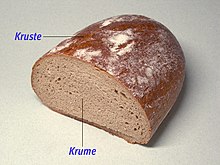Crumb (baked goods)

The inside of baked goods is called crumb (Austrian: Schmolle ) . The most important properties of the crumb are structure, elasticity , smell and taste . These are dependent
- from the dough guide
- the type of dough loosening
- on the type of baking process
- from the crust
- and about the baking ingredients.
The properties of the crumb are essential for assessing the quality of a baked product. It can be assessed according to its elasticity, cut resistance and sensory properties such as chewing properties or mouthfeel - properties that can be influenced by defects and bread diseases . The freshness level can be assessed based on the elasticity. The requirements of the crumb properties depend on the product. For example, the elasticity of the crumb is a factor in assessing the baking ability of rye flours in conjunction with sourdough . While a soft and restless crumb is sought for a baguette , for example , this does not apply to a stollen or a rustic wholemeal bread .
The taste and aroma of the crumb are not only influenced by the ingredients. In bread and rolls, the bread crust has a significant influence on these factors. In the crust, taste-determining substances are formed in the Maillard reaction as well as light and dark dextrins . When the baked goods cool down, a vacuum is created, which means that some of these aromas are transferred to the crumb.
Web links
Individual evidence
- ^ IREKS Arkady Institute for Bakery Science (ed.): IREKS ABC of the bakery. 4th edition. Institute for Bakery Science, Kulmbach 1985.
- ^ Handbook sourdough , editor: Gottfried Spicher, M. Brandt, Biologie, Biochemie, Technologie, 6th edition, 2006, Behr's Verlag, ISBN 3899471660 .
